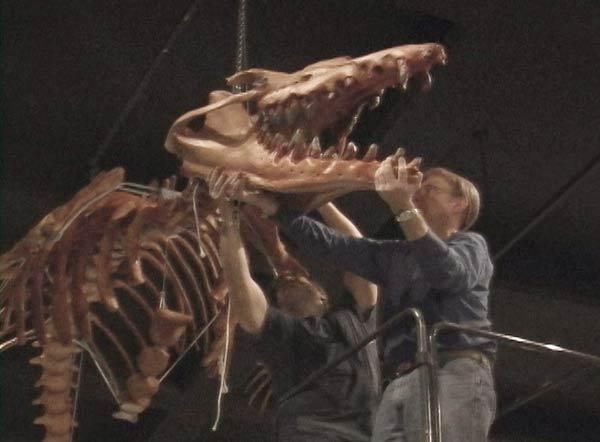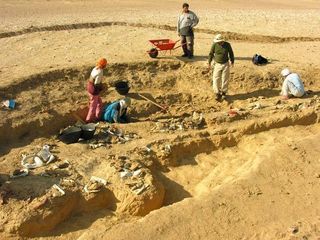
Prehistoric Giant is a Whale of an Evolutionary Tale

The University of Michigan's natural history museum has debuted a whale of a new exhibit: a complete fossil of the modern-day whale's ancient ancestor, whose bones reveal the mammal's strange evolutionary journey from land to sea.
The 50-foot-long (15 meters) skeleton of the extinct whale Basilosaurus isis, which lived 37 million years ago, is now suspended from the ceiling of the university's Exhibit Museum of Natural History. [Related: Amazing ancient beasts.]
"It's a spectacular fossil," said Exhibit Museum director Amy Harris, who added the fossil is the centerpiece of an exhibit on whale evolution , scheduled to open in April 2011. (The hanging skeleton is actually a fiberglass cast.)
The monster arrived in the Midwest by way of Egypt, in a journey that took more than two decades.
Philip Gingerich, a professor of paleontology and director of the University of Michigan's Museum of Paleontology, was the key force that brought the ancient remains to their new home.
A strange discovery
Since the 1980s, Gingerich and colleagues have located and mapped the remains of more than a thousand whales in an area of the Egyptian desert known as Wadi Hitan (Valley of the Whales), a UNESCO World Heritage site .
Sign up for the Live Science daily newsletter now
Get the world’s most fascinating discoveries delivered straight to your inbox.
The Basilosaurus skeleton was discovered in 1987, when a member of Gingerich's team found a bit of the whale's shoulder blade protruding from the sand. As he swept the sand away, he revealed the whale's lower jaws but the field season was almost over, so the team simply noted the fossil's location and covered it back up.
It wasn't until two years later that they were able to return and excavate the skull and lower jaws.
On that same return trip, Gingerich made an astonishing discovery.
Gingerich picked up what he thought was a piece of Basilosaurus rib. Upon closer examination, this "rib" turned out to be a small femur (thigh bone) of a mammal with a well-formed knee joint.

Suspecting that the diminutive leg belonged to Basilosaurus, Gingerich returned to a skeleton that was exposed in the desert sand, and quickly recognized another small leg, this one in its rightful place far down the lengthy vertebral column.
Armed with the new knowledge that at least some of these huge whales had legs and knees, Gingerich's team re-examined and excavated other Basilosaurus skeletons, with even more astonishing results.
The team unearthed specimens with a complete pelvis, leg bones, ankles and even toe bones. The giant whales' legs and feet were small and useless for walking, but they represented an important link to its terrestrial ancestors.
Gingerich kept busy with other fossil whales through the 1990s, working mainly in Pakistan, where his team found complete skeletons of early whales that could actually walk on land.
New home for ancient beast
The toothy giant now on display at the Michigan museum the very Basilosaurus that Gingerich's team discovered in1987 finally arrived in Michigan in 2007, when the painstaking process of cleaning the monster and making casts of its massive bones began.
The skeleton itself is far too heavy to suspend from the ceiling a single fossilized Basilosaurus vertebra weighs 35 pounds (16 kilograms). The specimen that now looms high above the museum floor is a foam-filled fiberglass cast of the prehistoric giant.
Gingerich said fitting the display together, piece by piece, was an educational experience, even for a man who has spent decades studying these whale ancestors.
"Just the act of mounting the skeleton makes you think about how the bones really fit together," Gingerich said, "and confront uncertainties that you would never realize you didn't understand until you try to put them together."












